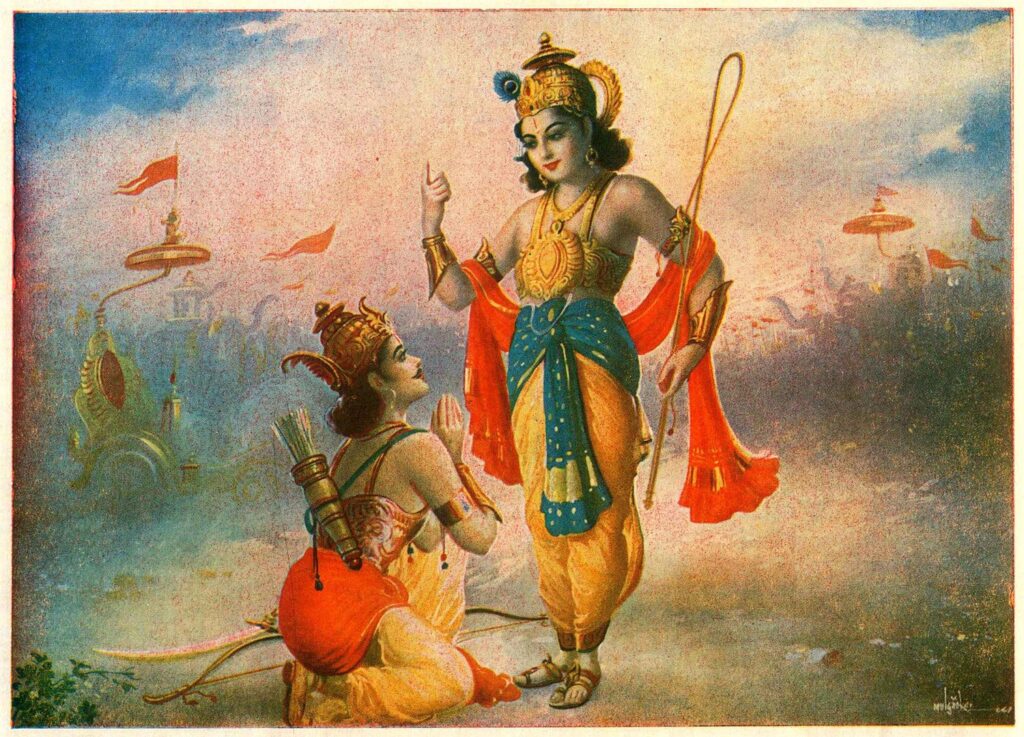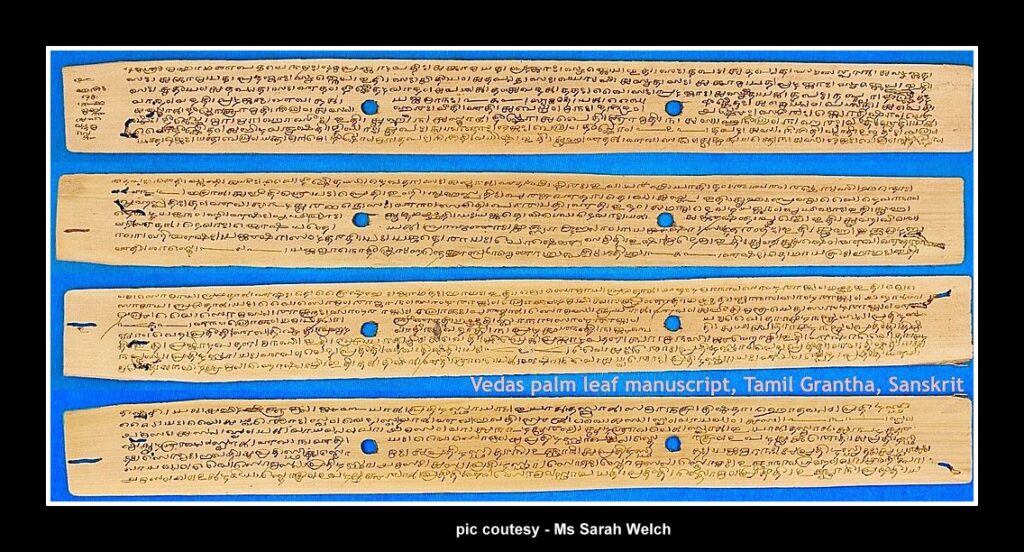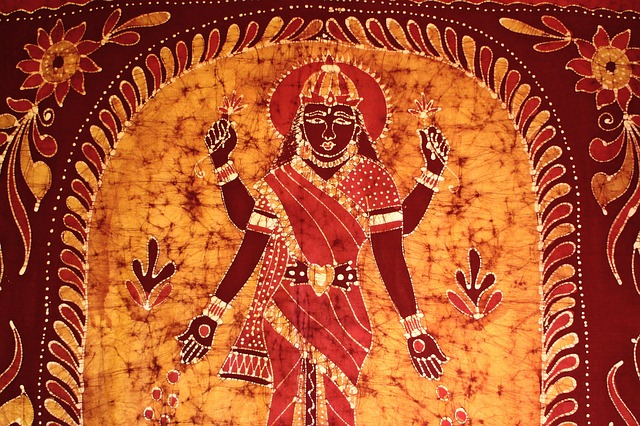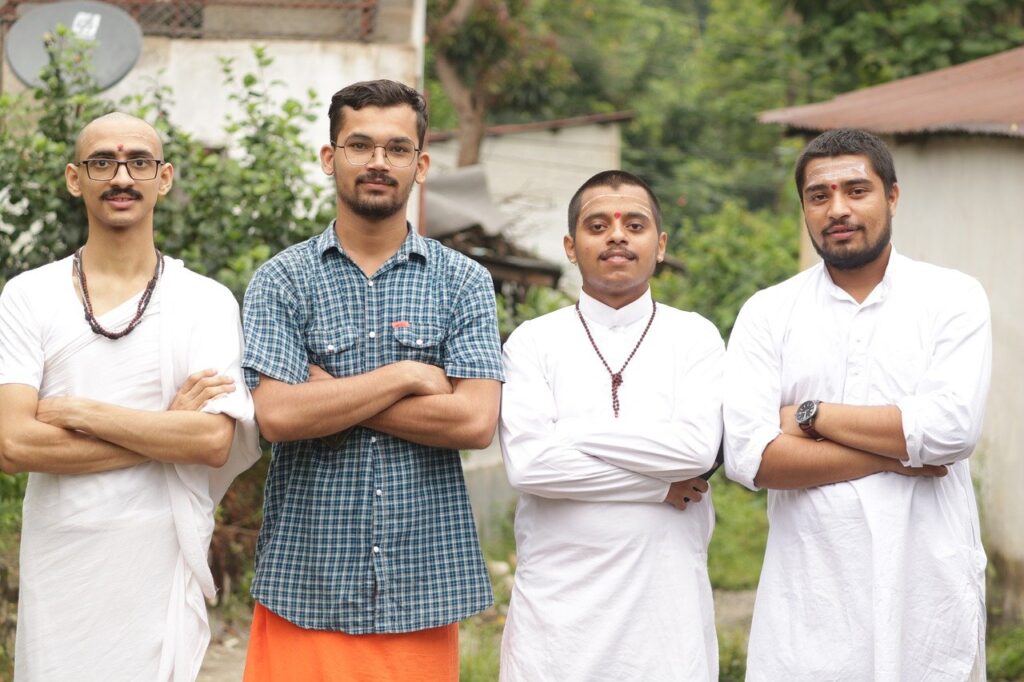
The Vedas are widely recognized as the oldest texts in Hinduism, thought to have been recorded approximately 2,500 years ago, though some traditions trace their origin back to the beginning of Kali yuga, around 3200 BC. These sacred scriptures are revered by many as the most authoritative and ancient literature in the world. Composed in Sanskrit, the Vedas originated in ancient India and were transcribed long ago, but they are believed to contain knowledge and wisdom that was passed down orally through a chain of disciplic succession for generations prior to their inscription. While some assert that there was only one Veda – the Yajur Veda, which was subsequently divided into four parts – others consider the Rig Veda to be the oldest of all Hindu writings.
#1 Meaning of the word ‘Veda’
The Vedic literature’s philosophical principles have endured over time and remain the preeminent religious authority on all aspects of Hinduism. The Vedas are highly regarded as a source of wisdom for humanity, beyond just the Hindu faith. Throughout history, the laws prescribed in the Vedas have governed the social, legal, domestic, and religious customs of Hindus, and continue to do so to this day. Vedic rituals guide all the obligatory duties of Hindus, from birth and marriage to death and beyond. The term “veda” in Sanskrit translates to “knowledge.” Some also describe the Vedas as “sruti literature,” meaning “that which is heard,” as distinct from other holy “smrti” texts, which are remembered. This highlights their status as direct utterances from the Divine and underscores their perceived divine origin (apaurusheya).

The term “Veda” encompasses three fundamental concepts, each of which reveals its profound connection with divine power –
- Firstly, the Vedic knowledge is eternal and timeless, embodying the wisdom of the Divine that transcends the limitations of space and time.
- Secondly, the Veda is the ultimate source of knowledge that grants us access to the Divine, allowing us to comprehend the true nature of God and establish a spiritual connection with the Supreme.
- Lastly, the Veda offers the most precious gift to our souls, which is the attainment of divine bliss through our communion with God.
#2 Origin of the Vedas
According to Vedic tradition, when the Supreme Lord created the material world, His transcendental energy pervaded every nook and cranny of it. This spiritual energy manifests as the pure vibration of shabda-brahma, through which the Supreme Himself can be perceived. The subtle vibration of spiritual sound, or shabda-brahman, was the first creation that emanated from the Supreme. Through worshiping this subtle form of the Vedas, mystics can purify their hearts of all faults and impurities acquired through material association and actions, thereby achieving liberation from the cycle of birth and death.

Srila Vyasadeva compiled the Vedic literature from this spiritual sound vibration. As the era of Kali-yuga dawned, the cognitive abilities of people began to decline. To preserve the sacred knowledge of the Vedas, the great sage Vyasadeva extracted the original four Vedas from the unwritten Veda. He wrote them down in Devanagari, also known as Sanskrit, the language of the gods.
Realizing that the Vedas were complex and difficult for the people of his time to understand, Vyasadeva compiled 18 Puranas, containing historical accounts of the material world in 382,000 verses. He also wrote the Mahabharata, an epic consisting of 200,000 verses, which included the famous Bhagavad-gita spoken by Lord Krishna Himself 5,000 years ago. Additionally, Vyasadeva compiled the 108 Upanishads (Vedanta) and summarized all of these literatures in a work called Vedanta-sutra (Brahma Sutra). However, he still felt that something was missing.
Upon discussing his concerns with his spiritual teacher, Narada, Vyasadeva was advised to write Srimad Bhagavatam. This renowned work of 18,000 verses contains the essence of all the Vedas and was compiled by Vyasadeva with great satisfaction. Sukadeva Goswami spoke the Srimad Bhagavatam to King Pariksit, the Emperor of the entire world. It is considered to be the ripened fruit of the Vedas.
#3 Structure of the Vedas
As most scholars of Vedic philosophy are aware, the term “Vedas” typically refers to the original four texts: the Rig, Yajur, Sama, and Atharva Vedas. The Brahmanas, which pertain to rituals and ceremonies, are derived from these four Vedas. The Aranyakas, in turn, are appendices of the Brahmanas. The Upanishads are the appendices of the Aranyakas, providing access to the secret and esoteric knowledge contained within.
The term “Veda” without an “s” can also be used to describe not only the four Vedas, but also the Brahmanas, Aranyakas, and Upanishads – in other words, all the texts that are considered Shruti.
The Four Vedas
Rig veda – It is the oldest of the Vedas and is divided into ten books (mandalas) and has 1028 hymns praising the various deities. These include Agni, Vishnu, Rudra, Varuna, and other early Vedic gods. It also contains the famous ‘Gayatri mantra’ and the ‘Purusha Shukta’ prayer.
Yajur Veda – A priestly handbook for use in the performance of yajnas (sacrifices).
Sama Veda – This consists of chants and melodies to be sung during worship and the performance of yajna.
Atharva Veda – Contains hymns, mantras, and chants, largely outside the scope of yajna.
Each of the four books that make up the Vedas can be divided into four different types of composition, as outlined below. In the strictest sense, only the samhitas comprise the true Vedas.

- The Samhitas are collections of hymns and mantras, and represent the Veda proper.
- The Brahmanas are prose manuals that provide guidance on ritual and prayer for the priests who perform them. They tend to explain the Samhitas and may contain early versions of some stories.
- The Aranyakas are philosophical treatises intended for hermits and saints and are known as the “forest books.”
- The Upanishads are books of philosophy and are also referred to as “Vedanta,” which means the end or conclusion of the Vedas.
Supplementary Literature
Supplementary literature closely associated with the Vedas includes two significant bodies of work:
- The Vedangas, which elaborate on the sciences necessary to comprehend and implement the Vedas.They include – Siksha (pronunciation), Vyakarana (grammar), Kalpa (ritual), Nirukti (etymology), chhandas (the study of prosody, which looks at poetic meter), Jyotish (Astrology).
- The Upavedas (often considered smriti), which cover the four conventional arts and sciences – Ayurveda (medicine), Gandharva veda (music and dance), Dhanur veda (warfare), and Shilpa veda (architecture).
#4 Vedas on the science of soul
Throughout history, philosophers have sought to answer the question of our true nature. Are we the body, the mind, or something more? The ancient Vedas of India provide clear answers to these questions. According to the Mundaka Upanishad, the living being is the soul. The Chandogya Upanishad and the Srimad-Bhagavatam also assert that the soul is eternal, unchanging, and indestructible. Lord Sri Krishna further explains in Bhagavad Gita that neither He nor any living being ever ceases to exist. Rather, the soul changes bodies as one would change clothes. Realizing one’s spiritual identity solves the problems and mysteries of life. The soul is self-luminous, beyond birth and death, and unlimited by time or space. Its size is described as microscopic and invisible to our material vision. The self is hidden in all beings and is higher and more subtle than the intellect.

“The essence of the living being, known as the soul, is of atomic size and can be apprehended by a perfect intellect. This soul is located within the heart and pervades the entire body of the living entity. Once the soul is free from the taint of the five kinds of material air, its spiritual potency becomes manifest” – Mukunda Upanishad (3.1.9)
The Gayatri Mantra, a revered hymn from the Rig Veda, which is believed to have emanated from the mouth of Lord Brahma, features a powerful prayer that calls upon the Supreme Lord’s effulgence and prays for His mercy –
“We meditate on that most adorable, most desirable and most enchanting effulgence of the Supreme Lord, who is the source of creation, inspiration and eternal happiness. May His light inspire and illumine our intellect.”
#5 Relevance of Vedic Culture today
The Vedic culture offers a wealth of knowledge and perspectives that are still relevant in modern times. From music, art, and architecture to astronomy, mathematics, and medicine, the contributions of Vedic culture have been significant and far-reaching. Vedic mathematics, for example, developed the system of carrying the remainder of one column of numbers over to the next, making calculations of large numbers easier than other systems. Additionally, the Vedic system invented the zero, which is one of the greatest developments in the history of mathematics.
Vedic practices are not limited to these fields alone. The Vedic culture also had an advanced understanding of medicine, with the recording of complicated surgeries like cesareans and cataracts as early as 600 BCE. Ayurveda, for instance, is the Vedic system of holistic medicine that focuses on healthy living and maintaining health as well as curing illnesses. Jyotish, or Vedic Astrology, is another ancient science that provides insight and guidance to individuals through mapping the structure of time and revealing the correlations between astronomical facts and terrestrial events. Vastu, the Vedic science of architecture, is focused on creating a living space that emulates the attributes of the cosmic space and brings the divine sentinels of cosmic directions into our homes, promoting balance and harmony.

The enduring power of dharma, as demonstrated by the continued relevance of ancient Vedic practices in modern times, can offer invaluable guidance in our pursuit of material and spiritual fulfillment. By tapping into the timeless wisdom of Vedas, we can access a source of knowledge that transcends time and helps us unlock our highest potential. Harnessing the eternal nature of dharma and its transformative power can help us create a better future for ourselves and future generations.